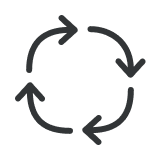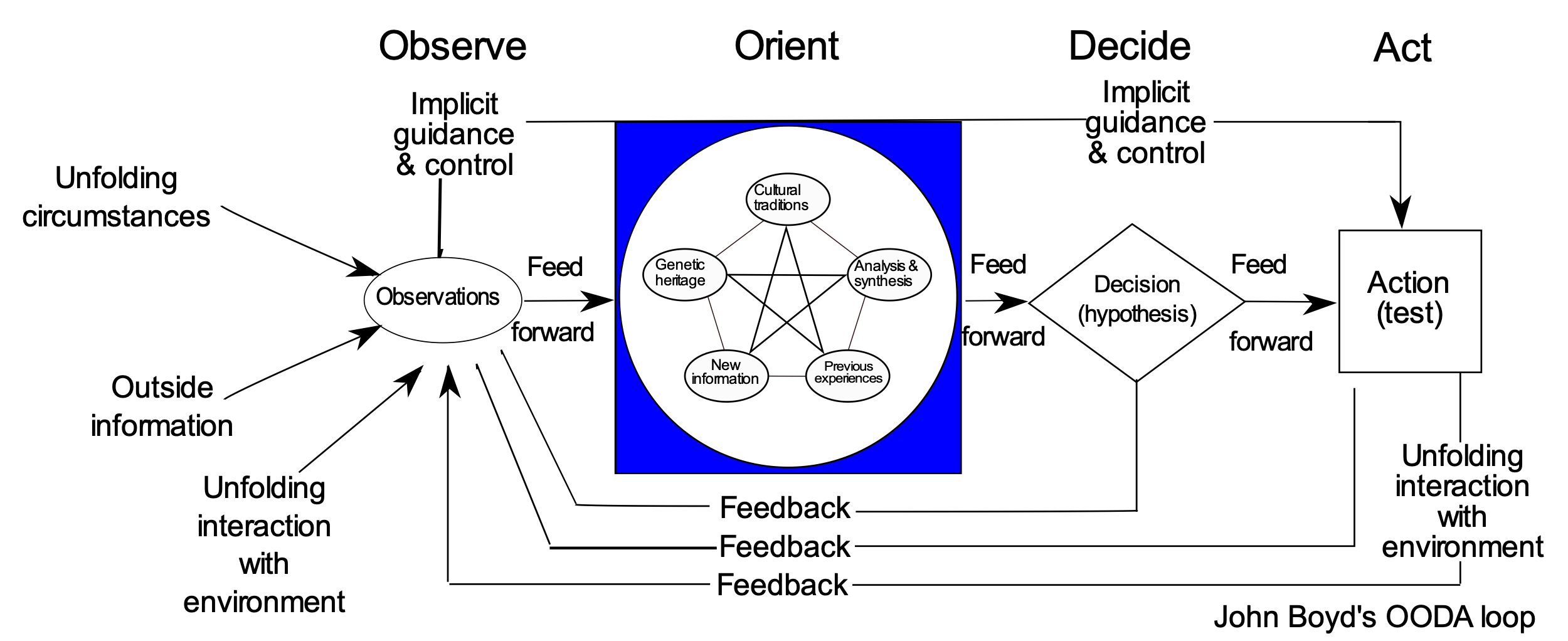
OODA loop
DECISION MAKINGIn the real world and especially in business, you rarely have all the information to make a decision. The OODA loop is a framework that helps you make decisions fast and adapt in quickly changing and competitive environments.
It was developed by Colonel John Boyd, a military strategist with the US Air Force. This framework was originally intended for training solders to make time-sensitive decisions rapidly when there may not be time to gather all the information. Nowadays, it is being applied across industries and is just as relevant for business.
How to use it
OODA stands for:
- Observe
- Orient
- Decide
- Act
The original framework as presented by Boyd (shown below) is much more complex but the foundation lies in these four phases. Let's look at each phase in detail.

Observe
You start by gathering available information and data. This includes the situation around you, wider context, any outside information but also feedback from a previous loop (more on this below). Note that data can become obsolete so it's important to gather data quickly, otherwise you run the risk of making a decision based on something that's no longer relevant or true.
Orient
Orientation is about analysing and synthesising the information gathered. It's where you consider your options, leveraging your experience, knowledge, and analysis to understand the situation. This phase often involves challenging status quo and considering the perspectives of others to form a comprehensive view.
Decide
The decision phase is where you choose a course of action based on your observation and orientation. In this phase, you are basically making a hypothesis and you will test by acting on it. It's crucial to balance speed with thoroughness – decisions must be timely but also informed and strategic.
Act
Finally, acting on your decision is about implementation. This phase tests the validity of your previous phases – you'll quickly learn if your observations and decisions were accurate.
Going through the loops
While being able to make decisions faster than your competition is important, speed alone isn't the only factor to focus on. Perhaps more important is getting into a good rhythm of going through the loops continuously because it generates unpredictability.
That makes it difficult for your competition to understand and orient themselves to what happens next. Going through OODA loops with more tempo than the competition gives an organization more control of the environment and a better chance of succeeding.
Example
Imagine a software company, 'TechGenius', that has recently launched a new project management tool. Suddenly, a competitor releases a similar tool with a unique feature that's gaining attention in the market.
Observe: The product team at TechGenius quickly gathers data. They monitor customer feedback, analyse market trends, and review the competitor's new feature. They also assess the impact of this feature on their own product's performance and customer satisfaction.
Orient: The team synthesises this information. They consider how this new feature fits into the broader market trends and what it means for their product strategy. They draw on their experience with past updates, current technology capabilities, and customer preferences. The team challenges their initial assumptions about their product's unique selling points and considers whether they need to pivot their strategy.
Decide: After thorough analysis, the team decides to develop a new feature that not only matches the competitor's offering but also integrates seamlessly with their tool's existing functionalities, offering added value to their customers.
Act: TechGenius quickly mobilises its development team to start working on the new feature. They set clear milestones and a timeline for development and launch. The marketing team begins preparing a campaign to announce the upcoming feature, aiming to recapture market attention.
As the new feature is developed and released, the team doesn't stop there. They re-enter the OODA loop, observing customer reactions, orienting themselves based on this feedback, deciding on any necessary adjustments, and acting to implement these changes.
In this scenario, TechGenius utilised the OODA Loop to rapidly respond to a competitive challenge. By swiftly moving through the observe-orient-decide-act phases, they were not only able to counter a competitor's move but also enhance their own product's value proposition, demonstrating the power of agility and adaptability in the fast-paced tech industry.
Takeaway
The OODA loop provides guidance to make fast decisions in quickly changing and competitive environments. You observe, orient, decide and act. It's important to go through the loop continuously, especially as you are competing with others. The faster you can do that, the better the chance of outmanoeuvring your competition.